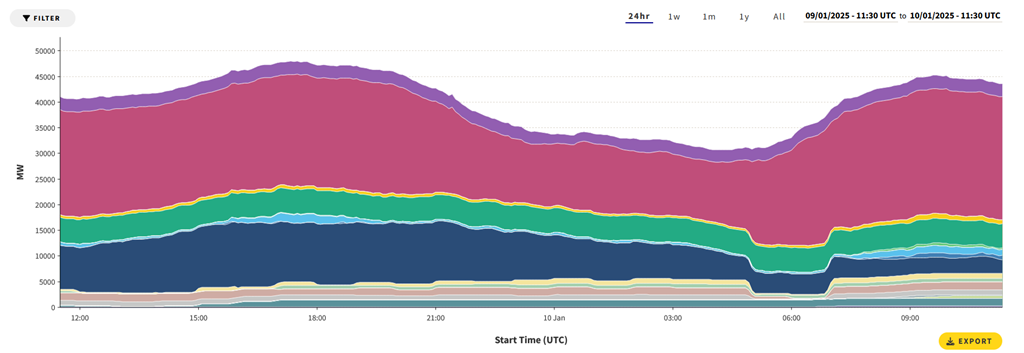From the MANHATTAN CONTRARIAN
Francis Menton
It has been obvious now for many years to the numerate that the fantasy future powered by wind and sun is not going to happen. Sooner or later, reality will inevitably intrude. And yet, the fantasy has gone on for far longer than I ever would have thought possible. Hundreds of billions of dollars of government largesse have been a big part of the reason, going not just to green energy developers but also to academic charlatans and environmental NGOs to fan the flames of climate alarm.
It was three years ago, in December 2021, that I asked the question, “Which Country Or U.S. State Will Be The First To Hit The Green Energy Wall?” The “green energy wall” would occur when addition of wind and solar generators to the grid could no longer continue, either due to regular blackouts or soaring costs or both. Candidates for first to hit the wall considered in that post included California, New York, Germany and the UK. I wrote then:
All these places, despite their wealth and seeming sophistication, are embarking on their ambitious plans without ever having conducted any kind of detailed engineering study of how their new proposed energy systems will work or how much they will cost. . . . As these jurisdictions ramp up their wind and solar generation, and gradually eliminate the coal and natural gas, sooner or later one or another of them is highly likely to hit a “wall” — that is, a situation where the electricity system stops functioning, or the price goes through the roof, or both, forcing a drastic alteration or even abandonment of the whole scheme.
Three years on, it looks like Germany is winning the race to the wall. After a couple of decades of “Energiewende,” Germany has closed all of its nuclear plants and much of its fossil fuel capacity, with a huge build-out of wind and solar generation. How’s that going? The German site NoTricksZone posts today an English translation of a piece yesterday by Fritz Vahrenholt at the site Klimanachrichten (Climate News). The translated headline is “Two brief periods of wind doldrums and Germany’s power supply reaches its limits.” Excerpt:
From November 2 to November 8 and from December 10 to December 13, Germany’s electricity supply from renewable energies collapsed as a typical winter weather situation with a lull in the wind and minimal solar irradiation led to supply shortages, high electricity imports and skyrocketing electricity prices. At times, over 20,000 MW, more than a quarter of Germany’s electricity requirements, had to be imported. Electricity prices rose tenfold (93.6 €ct/kWh).
They avoided blackouts this time (barely) by importing more than a quarter of their electricity during the times of wind/sun drought. But the sudden demands for huge imports caused the spot price of electricity in the markets to soar, affecting not only Germany but also the neighbors who supplied the power. Vahrenholt provides this map indicating the prices reached during the December wind/sun drought:

€ 936.28/MWh is almost $1 per kWh. And that’s a wholesale price; retail would be at least double. By contrast, average U.S. electricity prices are well under $0.20/kWh.
Vahrenholt reasonably attributes the huge price spikes to elimination of reliable nuclear and fossil fuel plants, leaving Germany subject to the vagaries of the wind and sun:
The reason [for the price spikes]: The socialist/green led coalition government and the prior Merkel governments had decommissioned 19 nuclear power plants (30% of Germany’s electricity demand) and 15 coal-fired power plants were taken off the grid on April 1, 2023 alone.
From Wolfgang Große Entrup, Managing Director of the German Chemical Industry Association:
“It’s desperate. Our companies and our country cannot afford fair-weather production. We urgently need power plants that can step in safely.”
It is also clear from Vahrenholtz’s map how Germany’s sudden surge of demand affected the countries that supplied the imports on short notice — particularly Norway, Sweden, the Netherlands, Denmark, and Austria. Here is the reaction in Norway:
Norway’s energy minister in the center-left government, Terja Aasland, wants to cut the power cable to Denmark and renegotiate the electricity contracts with Germany. He is thus responding to the demands of the right-wing Progress Party, which has been calling for this for a long time and will probably win the next elections. According to the Progress Party, the price infection from the south must be stopped.
And the same from Sweden:
Swedish Energy Minister Ebba Busch was even clearer: “It is difficult for an industrial economy to rely on the benevolence of the weather gods for its prosperity.” And directly to Habeck’s green policy: “No political will is strong enough to override the laws of physics – not even Mr. Habeck’s.”
When the neighbors decline to continue to supply Germany with imports during its wind/sun droughts, then it will be blackouts instead of price spikes. We continue to move slowly toward that inevitability.
In other news from Germany, its auto industry is struggling (also from soaring energy prices, not to mention EV mandates), and its government has just fallen. Economic growth has ground to a halt. This is what the green energy wall looks like. Elections will be held some time in the new year.
I’m feeling cautiously optimistic that the world will wake up from the green energy bad dream before the damage turns to disaster. Our incoming U.S. administration seems to have caught on. Germany, sorry you had to be the guinea pig for this failed experiment.
Related
Discover more from Watts Up With That?
Subscribe to get the latest posts sent to your email.








Leave a Comment